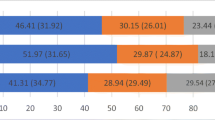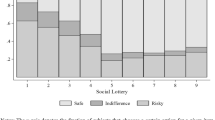Abstract
In this study, we investigate how economic agents choose gambling partners and how paired risky choices differ from individual ones. To this aim, we develop a simple model and design a laboratory experiment that allows us to compare individual versus paired decisions across two treatments, where pairs are, respectively, exogenously and endogenously formed. In both treatments, paired subjects decide individually and independently how to allocate their wealth over a portfolio of lotteries and fully commit to share any winnings. The main result from our experiment is that whenever agents are allowed to choose a gambling partner they decide to team up with other agents who display the same degree of risk aversion as themselves. Moreover, paired choices consistently involve higher risk taking than individual choices. This finding is more evident when information on subjects’ risk attitudes is made available and when subjects team up in homogeneous pairs, thereby confirming that subjects successfully exploit the benefits of mutual insurance.
Similar content being viewed by others
References
Attanasio, O., Barr, A., Cardenas, J. C., Genicot, G., & Meghir, C. (2009). Risk pooling, risk preferences, and social networks, mimeo.
Baker R. J., Laury S. K., Williams A. W. (2008) Comparing small-group and individual behaviour in lottery choice experiments. Southern Economic Journal 75: 367–382
Barr A., Genicot G. (2008) Risk pooling commitment and information: An experimental test. Journal of the European Economic Association 6: 1151–1185
Bateman I., Munro A. (2005) An experiment on risky choice amongst households. Economic Journal 115: 176–189
Becker G. S. (1973) A theory of marriage. Journal of Political Economy 81: 813–846
Bloch F., Genicot G., Ray D. (2008) Informal insurance in social networks. Journal of Economic Theory 143: 36–58
Bone J., Hey J., Suckling J. (1999) Are groups more (or less) consistent than individuals?. Journal of Risk and Uncertainty 18: 63–81
Bornstein G., Yaniv I. (1998) Individual and group behavior in the ultimatum game: Are groups more rational, players?. Experimental Economics 1: 101–108
Bramoullé Y., Kranton R. (2007a) Risk sharing across communities. American Economic Review 97: 70–74
Bramoullé Y., Kranton R. (2007b) Risk sharing networks. Journal of Economic Behaviour and Organization 64: 275–294
Cason T. V., Mui L. (1997) A laboratory study of group polarization in the team dictator game. Economic Journal 107: 1465–1483
Charness G. E., Karni E., Levin D. (2007) Individual and group decision making under risk: An experimental study of bayesian updating and violations of first-order stochastic dominance. Journal of Risk and Uncertainty 35: 129–148
Cox J. C. (2002) Trust, reciprocity, and other-regarding preferences: Groups vs. individuals and males vs. females. In: Zwick R., Rapoport A. (eds) Advances in experimental business research. Kluwer, Dordrecht, pp 331–350
Currarini S., Jackson M. O., Pin P. (2009) An economic model of friendship: Homophily, minorities and segregation. Econometrica 77: 1003–1045
De Weerdt J., Dercon S. (2006) Risk-sharing networks and insurance against illness. Journal of Development Economics 81: 337–356
Eliaz K., Ray D., Razin R. (2006) Choice shift in groups: A decision-theoretic basis. American Economic Review 96: 1321–1332
Fafchamps M., Lund S. (2003) Risk sharing networks in rural Philippines. Journal of Development Economics 71: 261–287
Genicot G., Ray D. (2003) Endogenous group formation in risk-sharing arrangements. Review of Economic Studies 70: 87–113
Ghatak M. (1999) Group lending, local information and peer selection. Journal of Development Economics 60: 27–50
Giné, X., Jakiela, P., Karlan, D., & Morduch, J. (2006). Microfinance games, mimeo.
Hayne S., Cox J. C. (2006) Barking up the right tree: Are small group rational agents?. Experimental Economics 9: 209–222
Harrison, G. W., Lau, M. I., Rustrom, E. & Tarazona Gomez, M. (2005). Preferences over social risk. University of Central Florida working paper no. 05-06.
Keller R.L., Sarin R.K., Sounderpandian J. (2007) An examination of ambiguity aversion: Are two heads better than one?. Judgment and Decision Making 2: 290–397
Kocher M. G., Sutter M. (2005) The decision maker matters: Individual versus group behaviour in experimental beauty-contest games. Economic Journal 115: 200–223
Kremer M. (1993) The O-Ring theory of economic development. Quarterly Journal of Economics 108: 551–575
Masclet D., Loheac Y., Denant-Boemont L., Colombier N. (2009) Group and individual risk preferences: A lottery-choice experiment. Journal of Economic Behavior and Organization 70: 470–484
McPherson M., Smith-Lovin L., Cook J. C. (2001) Birds of a feather: Homophily in social networks. Annual Review of Sociology 27: 415–444
Rockenbach B., Sadrieh A., Mathauschek B. (2007) Teams take the better risk. Journal of Economic Behavior and Organization 63: 412–422
Sadoulet, L. (2000). Equilibrium risk-matching in group lending, mimeo.
Shupp R. S., Williams A. W. (2008) Risk preference differential of small groups and individuals. Economic Journal 118: 258–283
Zhang, J., Casari, M. (2010). How groups reach agreements in risky choices: An experiment. Institute for Empirical Research in Economics, University of Zurich, working paper no. 506.
Author information
Authors and Affiliations
Corresponding author
Rights and permissions
About this article
Cite this article
Di Cagno, D., Sciubba, E. & Spallone, M. Choosing a gambling partner: testing a model of mutual insurance in the lab. Theory Decis 72, 537–571 (2012). https://doi.org/10.1007/s11238-011-9267-2
Published:
Issue Date:
DOI: https://doi.org/10.1007/s11238-011-9267-2




